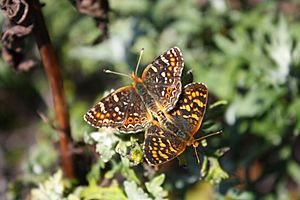Field crescent facts for kids
Quick facts for kids Field crescent |
|
|---|---|
 |
|
| Scientific classification | |
| Kingdom: | |
| Phylum: | |
| Class: | |
| Order: | |
| Family: | |
| Genus: |
Phyciodes
|
| Species: |
P. pulchella
|
| Binomial name | |
| Phyciodes pulchella (Boisduval, 1852)
|
|
| Synonyms | |
|
|
The field crescent (scientific name: Phyciodes pulchella) is a type of butterfly. It belongs to the Nymphalidae family, which is a large group of butterflies often called "brush-footed butterflies." You can find this butterfly in the Nearctic realm, which includes most of North America.
Contents
About the Field Crescent
The Field Crescent is a small to medium-sized butterfly. Its wingspan (how wide its wings are when spread out) is usually between 24 and 36 millimeters. That's about the length of a few paperclips! These butterflies are often seen flying from May to August in places like Canada.
What Do Field Crescent Larvae Eat?
The young Field Crescent butterflies, known as larvae or caterpillars, enjoy eating plants. They especially like plants from the Asteraceae family. This plant family includes many common flowers you might know, such as sunflowers, daisies, and asters.
Field Crescent Subspecies
Within the Field Crescent species, there are several different groups called subspecies. These groups might have small differences in their appearance or where they live. Here are some of the known subspecies:
- P. p. camillus
- P. p. deltarufa
- P. p. inornatus
- P. p. montana
- P. p. owimba
- P. p. pulchella
- P. p. tutchone
- P. p. shoshoni
- P. p. vallis
Similar Butterflies
The Field Crescent can look a lot like other crescent butterflies. Here are some similar species you might confuse it with:
- Phyciodes cocyta – known as the northern crescent
- Phyciodes batesii – known as the tawny crescent
- Phyciodes mylitta – known as the Mylitta crescent
- Phyciodes pallida – known as the pale crescent
- Phyciodes tharos – known as the pearl crescent

